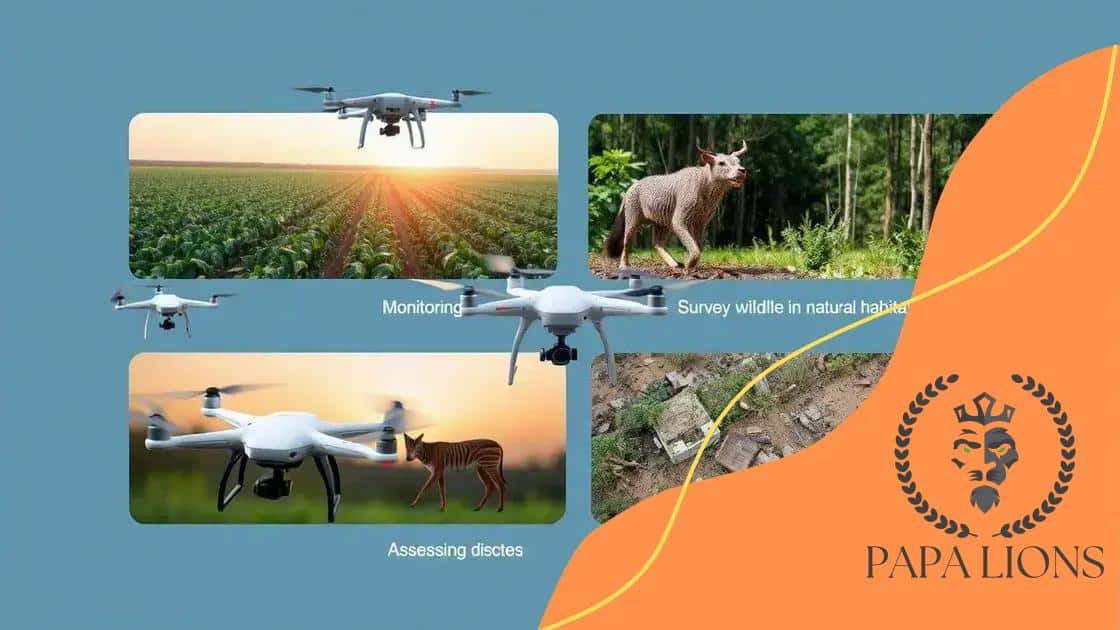Drone applications in environmental monitoring: a game changer

Drone applications in environmental monitoring leverage advanced technology to enhance data collection, improve efficiency, and provide critical insights for wildlife conservation, agriculture, and disaster response.
Drone applications in environmental monitoring are transforming how we observe and manage our ecosystems. Have you ever wondered how these flying devices gather crucial data to protect our planet? Let’s dive in!
Understanding drone technology in environmental science
Understanding drone technology in environmental science is crucial for harnessing its full potential. Drones are equipped with advanced sensors and cameras, allowing researchers to gather data from hard-to-reach places. By flying above forests, rivers, and urban areas, they provide a bird’s-eye view of ecosystems, enhancing our understanding of environmental dynamics.
Types of Drones Used in Environmental Monitoring
Different types of drones serve unique purposes. Some are designed for aerial surveys, while others excel in data collection. Here’s a look at common drone types:
- Fixed-wing drones for long-range monitoring.
- Quadcopters for detailed imaging in local areas.
- Hybrid models that offer versatility.
Each type has its strengths, making it possible to choose the best fit depending on specific monitoring needs. The flexibility of these technologies allows for tailored approaches in studying various environmental factors.
As we explore further, it’s important to understand how drone technology is integrated with advanced data analytics. Drones collect vast amounts of information, from temperature readings to vegetation health data. This data is then processed to create meaningful insights.
Applications in Environmental Research
Drones have numerous applications in environmental research. For instance, they can be used to track wildlife populations or assess the health of marine ecosystems. Some key applications include:
- Mapping deforestation and land use changes.
- Monitoring water quality in lakes and rivers.
- Assessing the impact of climate change.
These applications highlight how drones are invaluable tools for scientists, allowing them to collect comprehensive data efficiently.
In addition to research, drones support conservation efforts. They can monitor illegal activities like poaching or deforestation, providing real-time data to authorities. By offering a safe and efficient way to survey large areas, drones empower organizations to protect endangered species and preserve natural habitats.
Key benefits of using drones for monitoring
Key benefits of using drones for monitoring are reshaping the landscape of environmental observation. Drones provide unique advantages that traditional methods cannot match.
Efficiency and Cost-Effectiveness
Using drones for monitoring significantly reduces time and costs. Unlike manned aircraft or ground surveys, drones can cover vast areas quickly. They eliminate the need for extensive manpower, leading to reduced operational costs.
- Drones can fly lower and closer to their subjects.
- They require less fuel and maintenance than traditional aircraft.
- Real-time data collection enables immediate analysis.
This efficiency allows researchers to focus on interpretation rather than collection, facilitating faster decision-making.
Precision and Data Quality
The data gathered by drones is often more precise. Equipped with high-resolution cameras and various sensors, they capture detailed images and information.
For instance, using multispectral cameras, drones can monitor vegetation health accurately.
- High-resolution images reveal changes in land use.
- Sensors detect temperature variations and moisture levels.
- Data analytics can provide insights into ecosystem health.
This level of detail is essential for and critical in making effective environmental management decisions.
Moreover, drones can reach inaccessible areas, such as rugged terrains or disaster sites where human presence might be challenging. This capability ensures comprehensive monitoring of diverse environments.
Safety and Reduced Environmental Impact
Safety is a crucial factor in environmental monitoring. Drones minimize risks associated with fieldwork, especially in hazardous locations.
They can operate in dangerous areas without putting human lives at risk. Additionally, using drones is less intrusive than traditional methods. They have a smaller carbon footprint, leading to a lesser impact on wildlife and natural habitats.
These benefits collectively support sustainable practices, ensuring that monitoring activities contribute positively to environmental conservation.
Real-world examples of drone applications

Real-world examples of drone applications showcase how these innovative tools are transforming various industries. From agriculture to wildlife conservation, drones provide solutions that were once unimaginable.
Agricultural Monitoring
In agriculture, farmers use drones to monitor crop health efficiently. Drones equipped with multispectral cameras can identify issues like pests or diseases before they spread. This precision leads to:
- Improved yield predictions.
- Targeted pesticide application.
- Water usage optimization.
Farmers can respond swiftly to potential problems, ensuring healthier crops and maximizing profits.
Wildlife Conservation
Drones play a vital role in wildlife conservation efforts. They monitor endangered species, track migration patterns, and gather essential data for research. For example, drones can:
- Detect poaching in protected areas.
- Survey remote habitats without disturbing wildlife.
- Gather data on animal populations and behaviors.
This capability allows conservationists to implement timely protective measures and protect biodiversity.
Disaster Response and Recovery
After natural disasters, drones assist in rapid assessments. They provide aerial views of affected areas, helping first responders locate victims and assess damage. The use of drones in disaster scenarios has numerous benefits:
- Faster response times.
- Detailed mapping of disaster zones.
- Real-time data for effective resource allocation.
These quick assessments can save lives and help communities recover faster.
In addition to these applications, drones are also used in environmental monitoring, urban planning, and infrastructure inspection. Their versatility and efficiency make them invaluable tools across multiple sectors. By utilizing drone technology, organizations can gather precise data, streamline operations, and enhance decision-making processes.
Challenges in implementing drone monitoring
Challenges in implementing drone monitoring can be significant, but understanding them helps organizations develop effective strategies. As drone technology evolves, many obstacles remain in the path of widespread deployment.
Regulatory Hurdles
One major challenge is navigating the regulations surrounding drone use. Different countries have varying rules, often affecting where and how drones can operate.
- Airspace restrictions can limit operations.
- Licensing requirements may vary by region.
- Compliance with privacy laws is essential.
These regulations can create barriers for organizations wishing to utilize drone technology for monitoring.
Technical Limitations
Despite their advantages, drones face technical challenges that can hinder their performance. For instance, battery life is often limited, restricting flight times. Additionally, signal loss in remote areas can complicate operations.
- Weather conditions can affect flight safety.
- Sensor capabilities may need enhancement for specific applications.
- Data processing requires significant computational resources.
Understanding these limitations is crucial for effective planning and execution of drone monitoring initiatives.
Cost Considerations
The initial investment for drone technology can be high. Costs for purchasing drones, training operators, and maintaining equipment can be daunting, especially for smaller organizations.
Despite the long-term savings, many companies may hesitate to invest in drone technology. To overcome this, businesses need to evaluate the potential return on investment carefully. Engaging in pilot programs can help organizations assess the benefits before significant investments.
Moreover, ongoing maintenance and software updates contribute to the overall cost of ownership. Organizations must weigh these financial factors before implementing drone monitoring solutions.
As the industry grows, addressing these challenges becomes vital for effective drone deployment. By understanding regulatory, technical, and financial barriers, businesses can develop strategies to maximize the benefits of drone monitoring.
Future trends in drone technology for ecology
Future trends in drone technology for ecology are evolving rapidly, fueled by advancements in technology and growing environmental awareness. As we look forward, several key trends are emerging that will shape how drones are used in ecological monitoring.
Integration of AI and Machine Learning
One of the most exciting trends is the integration of artificial intelligence (AI) and machine learning with drone technology. This combination allows drones to analyze data in real time. For example, AI can help identify different species of plants and animals from images captured by drones. This leads to more effective monitoring and data collection.
- Enhanced data processing speed.
- Increased accuracy in species identification.
- Automated monitoring tasks.
Such advancements can significantly reduce the workload for researchers and conservationists.
Increased Use of Autonomous Drones
Another trend is the rise of autonomous drones. These drones can fly predefined routes without human intervention. This capability allows for:
- Continuous monitoring of large areas.
- Reduced operational costs.
- Higher frequency of data collection.
Autonomous drones can survey ecosystems more efficiently, providing critical data for ongoing research.
Improved Sensor Technology
Future drones will feature advanced sensor technologies. Enhanced sensors can capture multi-spectral and hyper-spectral images, providing more comprehensive data on vegetation health and soil conditions. This progress supports:
- Better understanding of ecosystem dynamics.
- More precise mapping of biodiversity.
- Early detection of environmental changes.
With improved sensors, drones will be better equipped to support ecological studies and conservation efforts.
As these trends continue to develop, the role of drones in ecology will expand, supporting more sustainable practices and enhanced environmental management. By leveraging these future advancements, researchers can gain deeper insights into ecosystems and work more effectively toward conservation goals.
In conclusion, the future of drone technology in ecology looks promising. As we integrate AI and machine learning, we will see significant improvements in data collection and analysis. Autonomous drones will enhance our ability to monitor large areas efficiently. Moreover, advancements in sensor technology will provide deeper insights into ecosystems, aiding conservation efforts. By embracing these future trends, we can better understand and protect our environment.
\n\n
\n
FAQ – Frequently Asked Questions about Drone Applications in Environmental Monitoring
How are drones used in agricultural monitoring?
Drones help farmers monitor crop health by capturing high-resolution images and using sensors to identify issues like pests or diseases early.
What are the main benefits of using drones in wildlife conservation?
Drones provide a safe way to track wildlife, monitor populations, and detect poaching activities without disturbing the animals.
What challenges do organizations face when implementing drone technology?
Challenges include regulatory hurdles, technical limitations, and the high initial costs of drone systems.
What future trends can we expect in drone technology for ecology?
Future trends include the integration of AI for real-time data analysis, the use of autonomous drones for continuous monitoring, and advancements in sensor technology.





